Cloud ERP in SME
VerifiedAdded on 2022/11/18
|7
|1110
|246
AI Summary
This paper aims to research about the skills and resources required for implementing Cloud ERP (Enterprise Resource Planning) in SMEs. The discussion part of this paper will briefly illustrate the requirements for the implementation and the benefits that will be served will also be discussed.
Contribute Materials
Your contribution can guide someone’s learning journey. Share your
documents today.

Running head: CLOUD ERP IN SME
CLOUD ERP IN SME
Name of the Student
Name of the University
Author Note
CLOUD ERP IN SME
Name of the Student
Name of the University
Author Note
Secure Best Marks with AI Grader
Need help grading? Try our AI Grader for instant feedback on your assignments.
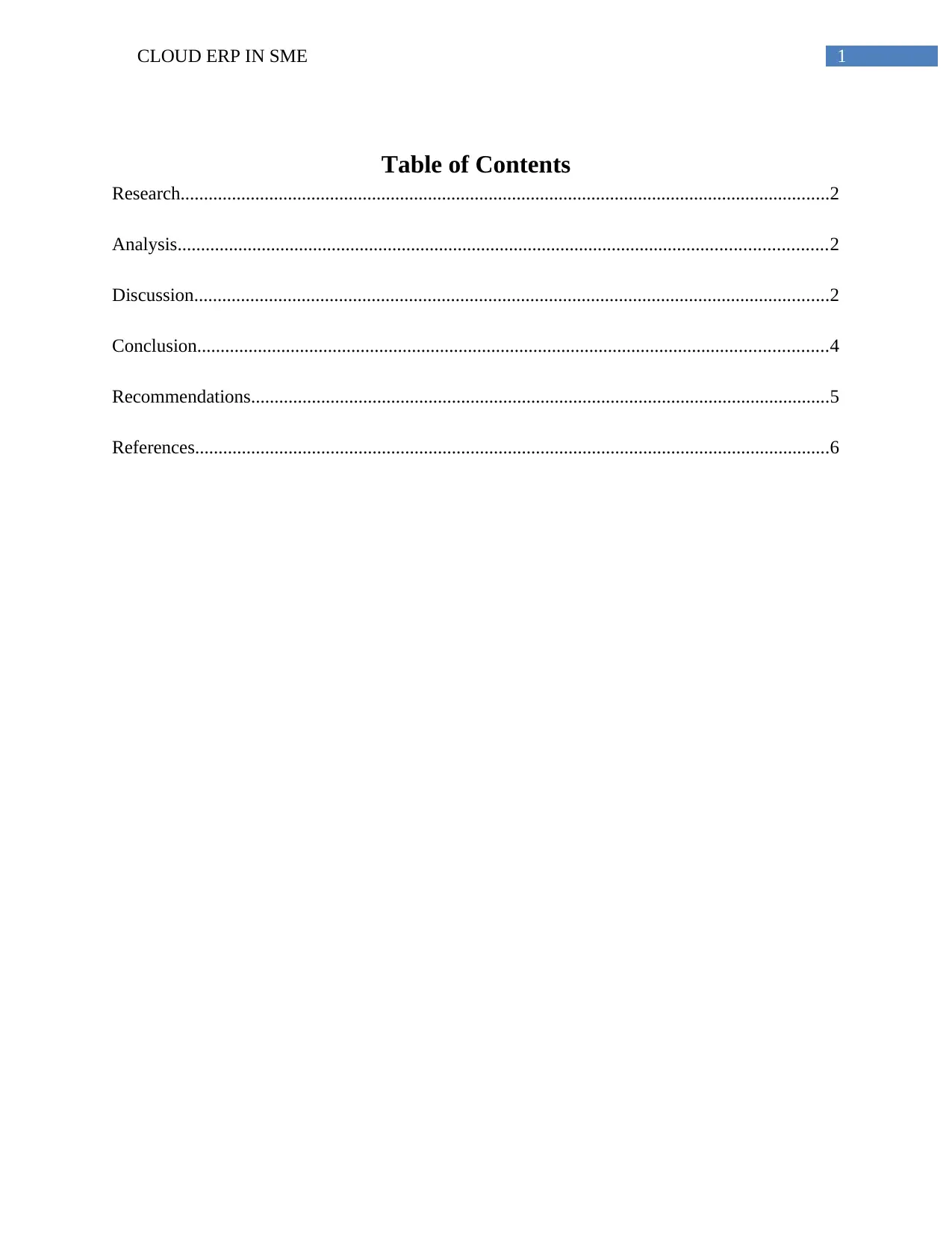
1CLOUD ERP IN SME
Table of Contents
Research...........................................................................................................................................2
Analysis...........................................................................................................................................2
Discussion........................................................................................................................................2
Conclusion.......................................................................................................................................4
Recommendations............................................................................................................................5
References........................................................................................................................................6
Table of Contents
Research...........................................................................................................................................2
Analysis...........................................................................................................................................2
Discussion........................................................................................................................................2
Conclusion.......................................................................................................................................4
Recommendations............................................................................................................................5
References........................................................................................................................................6
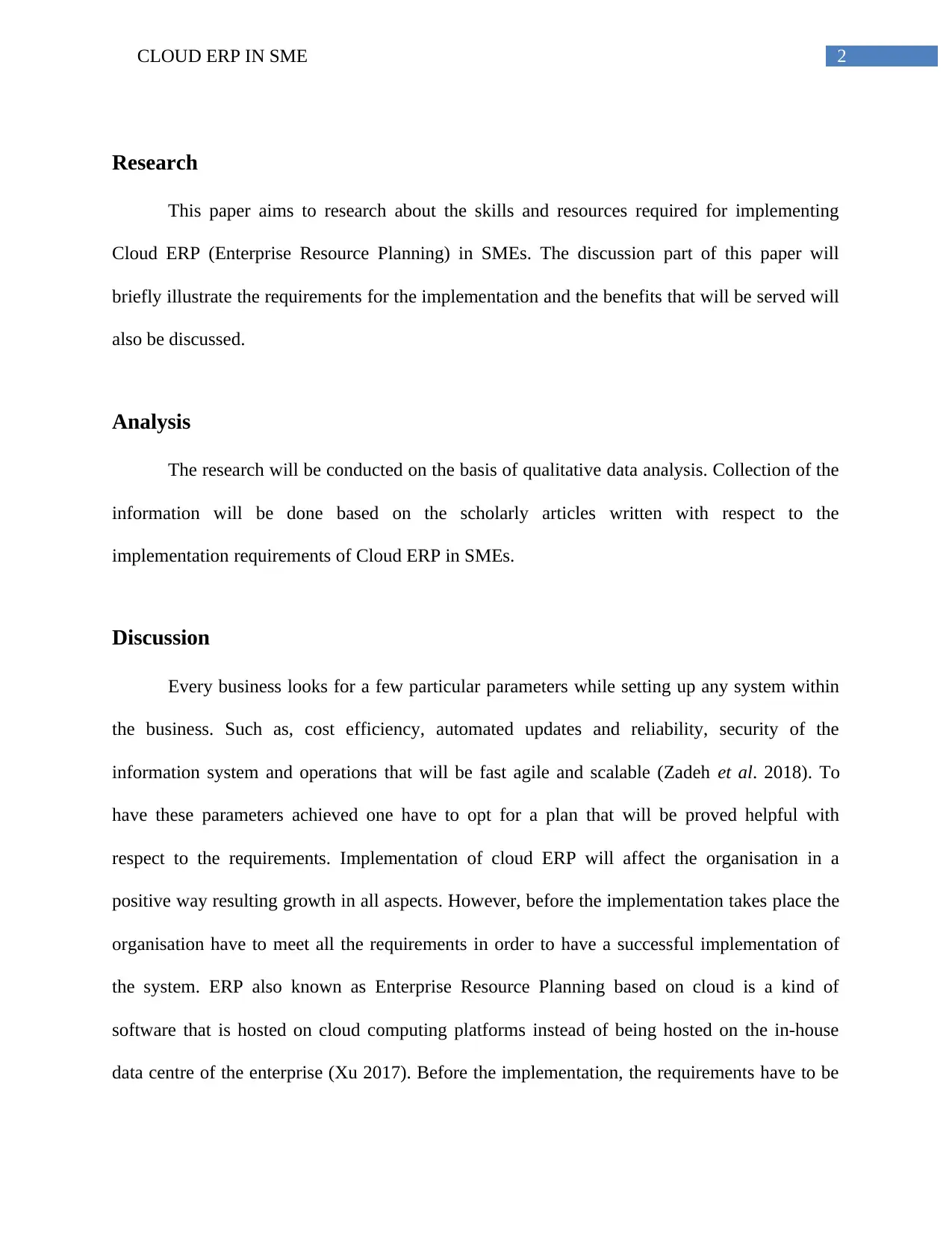
2CLOUD ERP IN SME
Research
This paper aims to research about the skills and resources required for implementing
Cloud ERP (Enterprise Resource Planning) in SMEs. The discussion part of this paper will
briefly illustrate the requirements for the implementation and the benefits that will be served will
also be discussed.
Analysis
The research will be conducted on the basis of qualitative data analysis. Collection of the
information will be done based on the scholarly articles written with respect to the
implementation requirements of Cloud ERP in SMEs.
Discussion
Every business looks for a few particular parameters while setting up any system within
the business. Such as, cost efficiency, automated updates and reliability, security of the
information system and operations that will be fast agile and scalable (Zadeh et al. 2018). To
have these parameters achieved one have to opt for a plan that will be proved helpful with
respect to the requirements. Implementation of cloud ERP will affect the organisation in a
positive way resulting growth in all aspects. However, before the implementation takes place the
organisation have to meet all the requirements in order to have a successful implementation of
the system. ERP also known as Enterprise Resource Planning based on cloud is a kind of
software that is hosted on cloud computing platforms instead of being hosted on the in-house
data centre of the enterprise (Xu 2017). Before the implementation, the requirements have to be
Research
This paper aims to research about the skills and resources required for implementing
Cloud ERP (Enterprise Resource Planning) in SMEs. The discussion part of this paper will
briefly illustrate the requirements for the implementation and the benefits that will be served will
also be discussed.
Analysis
The research will be conducted on the basis of qualitative data analysis. Collection of the
information will be done based on the scholarly articles written with respect to the
implementation requirements of Cloud ERP in SMEs.
Discussion
Every business looks for a few particular parameters while setting up any system within
the business. Such as, cost efficiency, automated updates and reliability, security of the
information system and operations that will be fast agile and scalable (Zadeh et al. 2018). To
have these parameters achieved one have to opt for a plan that will be proved helpful with
respect to the requirements. Implementation of cloud ERP will affect the organisation in a
positive way resulting growth in all aspects. However, before the implementation takes place the
organisation have to meet all the requirements in order to have a successful implementation of
the system. ERP also known as Enterprise Resource Planning based on cloud is a kind of
software that is hosted on cloud computing platforms instead of being hosted on the in-house
data centre of the enterprise (Xu 2017). Before the implementation, the requirements have to be
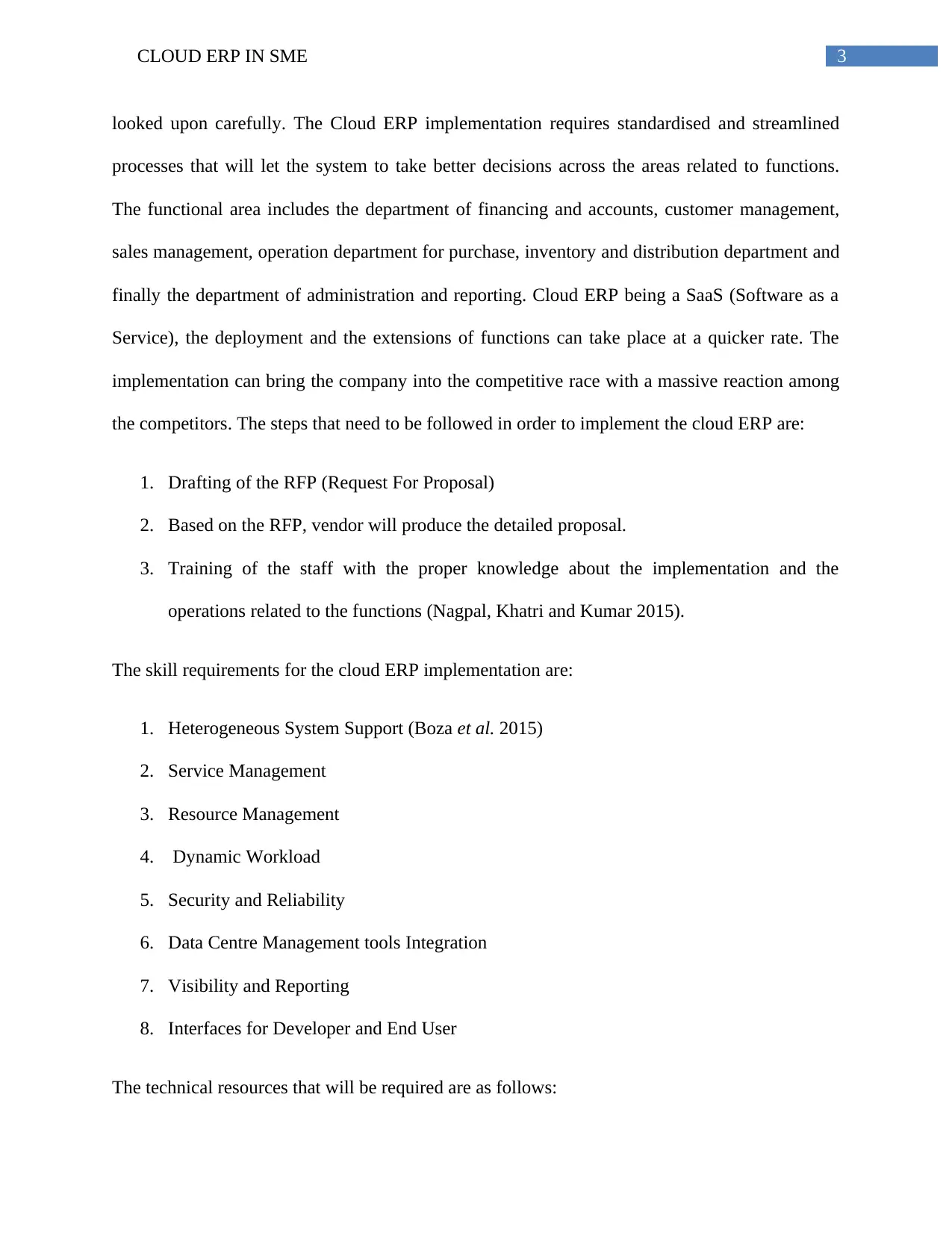
3CLOUD ERP IN SME
looked upon carefully. The Cloud ERP implementation requires standardised and streamlined
processes that will let the system to take better decisions across the areas related to functions.
The functional area includes the department of financing and accounts, customer management,
sales management, operation department for purchase, inventory and distribution department and
finally the department of administration and reporting. Cloud ERP being a SaaS (Software as a
Service), the deployment and the extensions of functions can take place at a quicker rate. The
implementation can bring the company into the competitive race with a massive reaction among
the competitors. The steps that need to be followed in order to implement the cloud ERP are:
1. Drafting of the RFP (Request For Proposal)
2. Based on the RFP, vendor will produce the detailed proposal.
3. Training of the staff with the proper knowledge about the implementation and the
operations related to the functions (Nagpal, Khatri and Kumar 2015).
The skill requirements for the cloud ERP implementation are:
1. Heterogeneous System Support (Boza et al. 2015)
2. Service Management
3. Resource Management
4. Dynamic Workload
5. Security and Reliability
6. Data Centre Management tools Integration
7. Visibility and Reporting
8. Interfaces for Developer and End User
The technical resources that will be required are as follows:
looked upon carefully. The Cloud ERP implementation requires standardised and streamlined
processes that will let the system to take better decisions across the areas related to functions.
The functional area includes the department of financing and accounts, customer management,
sales management, operation department for purchase, inventory and distribution department and
finally the department of administration and reporting. Cloud ERP being a SaaS (Software as a
Service), the deployment and the extensions of functions can take place at a quicker rate. The
implementation can bring the company into the competitive race with a massive reaction among
the competitors. The steps that need to be followed in order to implement the cloud ERP are:
1. Drafting of the RFP (Request For Proposal)
2. Based on the RFP, vendor will produce the detailed proposal.
3. Training of the staff with the proper knowledge about the implementation and the
operations related to the functions (Nagpal, Khatri and Kumar 2015).
The skill requirements for the cloud ERP implementation are:
1. Heterogeneous System Support (Boza et al. 2015)
2. Service Management
3. Resource Management
4. Dynamic Workload
5. Security and Reliability
6. Data Centre Management tools Integration
7. Visibility and Reporting
8. Interfaces for Developer and End User
The technical resources that will be required are as follows:
Secure Best Marks with AI Grader
Need help grading? Try our AI Grader for instant feedback on your assignments.
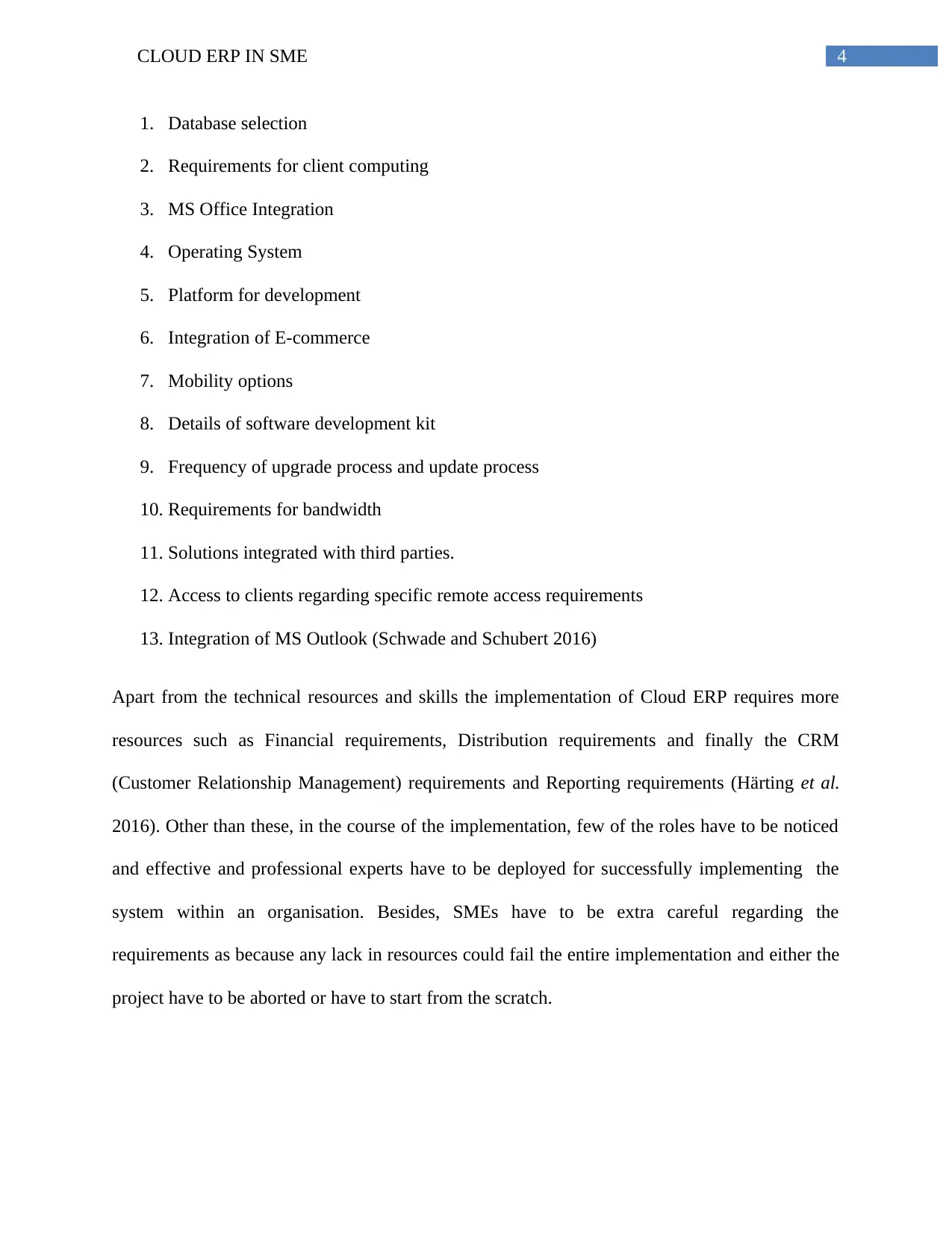
4CLOUD ERP IN SME
1. Database selection
2. Requirements for client computing
3. MS Office Integration
4. Operating System
5. Platform for development
6. Integration of E-commerce
7. Mobility options
8. Details of software development kit
9. Frequency of upgrade process and update process
10. Requirements for bandwidth
11. Solutions integrated with third parties.
12. Access to clients regarding specific remote access requirements
13. Integration of MS Outlook (Schwade and Schubert 2016)
Apart from the technical resources and skills the implementation of Cloud ERP requires more
resources such as Financial requirements, Distribution requirements and finally the CRM
(Customer Relationship Management) requirements and Reporting requirements (Härting et al.
2016). Other than these, in the course of the implementation, few of the roles have to be noticed
and effective and professional experts have to be deployed for successfully implementing the
system within an organisation. Besides, SMEs have to be extra careful regarding the
requirements as because any lack in resources could fail the entire implementation and either the
project have to be aborted or have to start from the scratch.
1. Database selection
2. Requirements for client computing
3. MS Office Integration
4. Operating System
5. Platform for development
6. Integration of E-commerce
7. Mobility options
8. Details of software development kit
9. Frequency of upgrade process and update process
10. Requirements for bandwidth
11. Solutions integrated with third parties.
12. Access to clients regarding specific remote access requirements
13. Integration of MS Outlook (Schwade and Schubert 2016)
Apart from the technical resources and skills the implementation of Cloud ERP requires more
resources such as Financial requirements, Distribution requirements and finally the CRM
(Customer Relationship Management) requirements and Reporting requirements (Härting et al.
2016). Other than these, in the course of the implementation, few of the roles have to be noticed
and effective and professional experts have to be deployed for successfully implementing the
system within an organisation. Besides, SMEs have to be extra careful regarding the
requirements as because any lack in resources could fail the entire implementation and either the
project have to be aborted or have to start from the scratch.
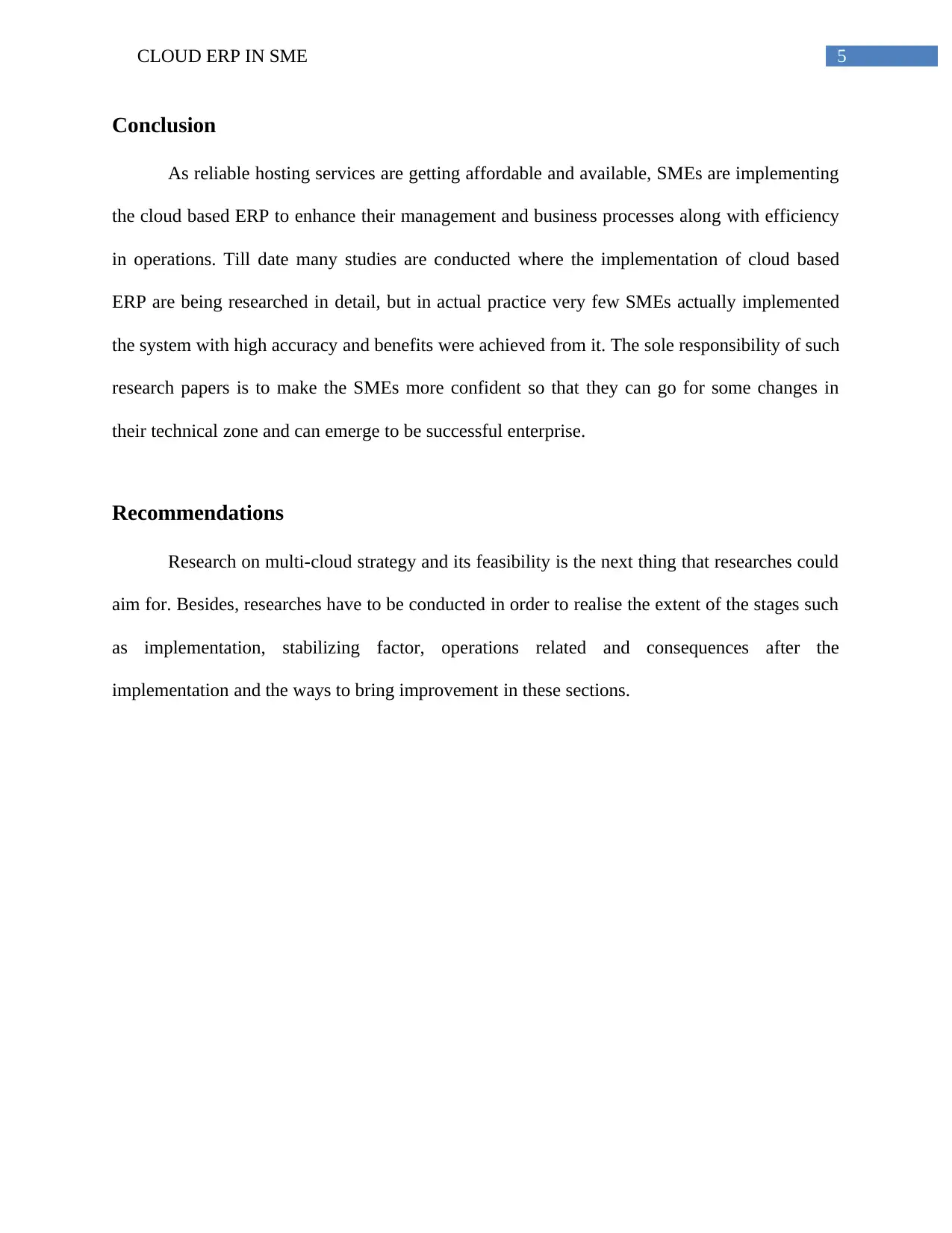
5CLOUD ERP IN SME
Conclusion
As reliable hosting services are getting affordable and available, SMEs are implementing
the cloud based ERP to enhance their management and business processes along with efficiency
in operations. Till date many studies are conducted where the implementation of cloud based
ERP are being researched in detail, but in actual practice very few SMEs actually implemented
the system with high accuracy and benefits were achieved from it. The sole responsibility of such
research papers is to make the SMEs more confident so that they can go for some changes in
their technical zone and can emerge to be successful enterprise.
Recommendations
Research on multi-cloud strategy and its feasibility is the next thing that researches could
aim for. Besides, researches have to be conducted in order to realise the extent of the stages such
as implementation, stabilizing factor, operations related and consequences after the
implementation and the ways to bring improvement in these sections.
Conclusion
As reliable hosting services are getting affordable and available, SMEs are implementing
the cloud based ERP to enhance their management and business processes along with efficiency
in operations. Till date many studies are conducted where the implementation of cloud based
ERP are being researched in detail, but in actual practice very few SMEs actually implemented
the system with high accuracy and benefits were achieved from it. The sole responsibility of such
research papers is to make the SMEs more confident so that they can go for some changes in
their technical zone and can emerge to be successful enterprise.
Recommendations
Research on multi-cloud strategy and its feasibility is the next thing that researches could
aim for. Besides, researches have to be conducted in order to realise the extent of the stages such
as implementation, stabilizing factor, operations related and consequences after the
implementation and the ways to bring improvement in these sections.
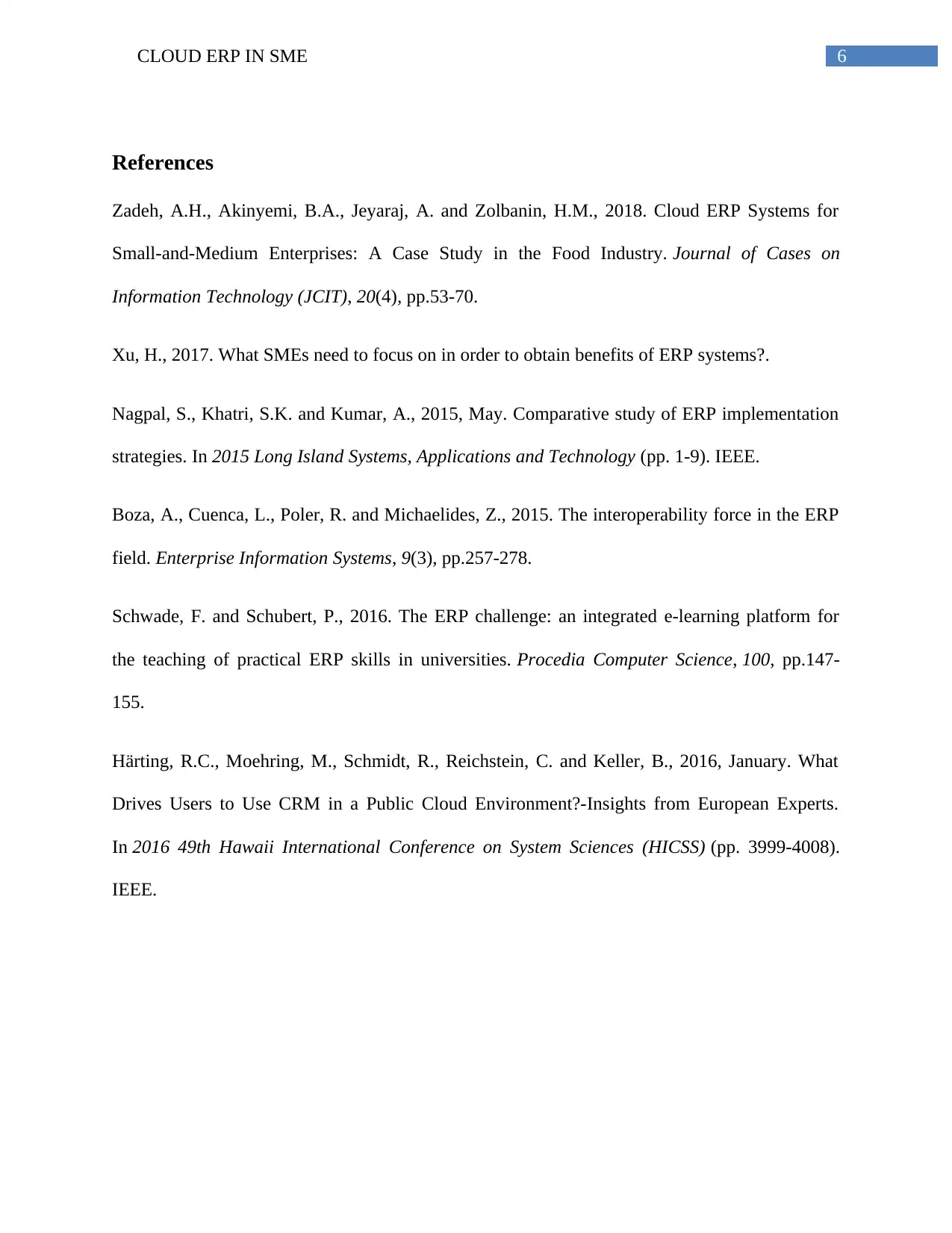
6CLOUD ERP IN SME
References
Zadeh, A.H., Akinyemi, B.A., Jeyaraj, A. and Zolbanin, H.M., 2018. Cloud ERP Systems for
Small-and-Medium Enterprises: A Case Study in the Food Industry. Journal of Cases on
Information Technology (JCIT), 20(4), pp.53-70.
Xu, H., 2017. What SMEs need to focus on in order to obtain benefits of ERP systems?.
Nagpal, S., Khatri, S.K. and Kumar, A., 2015, May. Comparative study of ERP implementation
strategies. In 2015 Long Island Systems, Applications and Technology (pp. 1-9). IEEE.
Boza, A., Cuenca, L., Poler, R. and Michaelides, Z., 2015. The interoperability force in the ERP
field. Enterprise Information Systems, 9(3), pp.257-278.
Schwade, F. and Schubert, P., 2016. The ERP challenge: an integrated e-learning platform for
the teaching of practical ERP skills in universities. Procedia Computer Science, 100, pp.147-
155.
Härting, R.C., Moehring, M., Schmidt, R., Reichstein, C. and Keller, B., 2016, January. What
Drives Users to Use CRM in a Public Cloud Environment?-Insights from European Experts.
In 2016 49th Hawaii International Conference on System Sciences (HICSS) (pp. 3999-4008).
IEEE.
References
Zadeh, A.H., Akinyemi, B.A., Jeyaraj, A. and Zolbanin, H.M., 2018. Cloud ERP Systems for
Small-and-Medium Enterprises: A Case Study in the Food Industry. Journal of Cases on
Information Technology (JCIT), 20(4), pp.53-70.
Xu, H., 2017. What SMEs need to focus on in order to obtain benefits of ERP systems?.
Nagpal, S., Khatri, S.K. and Kumar, A., 2015, May. Comparative study of ERP implementation
strategies. In 2015 Long Island Systems, Applications and Technology (pp. 1-9). IEEE.
Boza, A., Cuenca, L., Poler, R. and Michaelides, Z., 2015. The interoperability force in the ERP
field. Enterprise Information Systems, 9(3), pp.257-278.
Schwade, F. and Schubert, P., 2016. The ERP challenge: an integrated e-learning platform for
the teaching of practical ERP skills in universities. Procedia Computer Science, 100, pp.147-
155.
Härting, R.C., Moehring, M., Schmidt, R., Reichstein, C. and Keller, B., 2016, January. What
Drives Users to Use CRM in a Public Cloud Environment?-Insights from European Experts.
In 2016 49th Hawaii International Conference on System Sciences (HICSS) (pp. 3999-4008).
IEEE.
1 out of 7
Related Documents
Your All-in-One AI-Powered Toolkit for Academic Success.
+13062052269
info@desklib.com
Available 24*7 on WhatsApp / Email
![[object Object]](/_next/static/media/star-bottom.7253800d.svg)
Unlock your academic potential
© 2024 | Zucol Services PVT LTD | All rights reserved.



